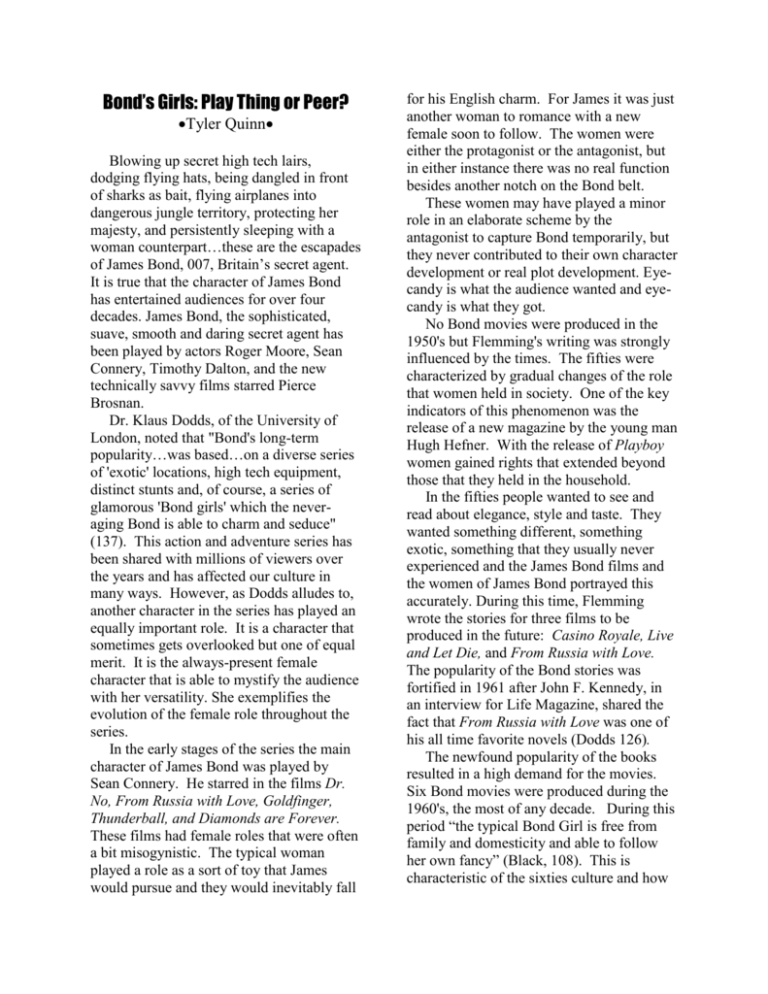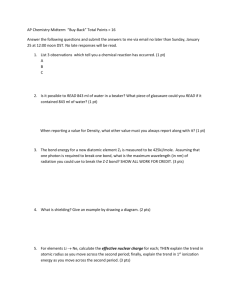
Bond’s Girls: Play Thing or Peer?
Tyler Quinn
Blowing up secret high tech lairs,
dodging flying hats, being dangled in front
of sharks as bait, flying airplanes into
dangerous jungle territory, protecting her
majesty, and persistently sleeping with a
woman counterpart…these are the escapades
of James Bond, 007, Britain’s secret agent.
It is true that the character of James Bond
has entertained audiences for over four
decades. James Bond, the sophisticated,
suave, smooth and daring secret agent has
been played by actors Roger Moore, Sean
Connery, Timothy Dalton, and the new
technically savvy films starred Pierce
Brosnan.
Dr. Klaus Dodds, of the University of
London, noted that "Bond's long-term
popularity…was based…on a diverse series
of 'exotic' locations, high tech equipment,
distinct stunts and, of course, a series of
glamorous 'Bond girls' which the neveraging Bond is able to charm and seduce"
(137). This action and adventure series has
been shared with millions of viewers over
the years and has affected our culture in
many ways. However, as Dodds alludes to,
another character in the series has played an
equally important role. It is a character that
sometimes gets overlooked but one of equal
merit. It is the always-present female
character that is able to mystify the audience
with her versatility. She exemplifies the
evolution of the female role throughout the
series.
In the early stages of the series the main
character of James Bond was played by
Sean Connery. He starred in the films Dr.
No, From Russia with Love, Goldfinger,
Thunderball, and Diamonds are Forever.
These films had female roles that were often
a bit misogynistic. The typical woman
played a role as a sort of toy that James
would pursue and they would inevitably fall
for his English charm. For James it was just
another woman to romance with a new
female soon to follow. The women were
either the protagonist or the antagonist, but
in either instance there was no real function
besides another notch on the Bond belt.
These women may have played a minor
role in an elaborate scheme by the
antagonist to capture Bond temporarily, but
they never contributed to their own character
development or real plot development. Eyecandy is what the audience wanted and eyecandy is what they got.
No Bond movies were produced in the
1950's but Flemming's writing was strongly
influenced by the times. The fifties were
characterized by gradual changes of the role
that women held in society. One of the key
indicators of this phenomenon was the
release of a new magazine by the young man
Hugh Hefner. With the release of Playboy
women gained rights that extended beyond
those that they held in the household.
In the fifties people wanted to see and
read about elegance, style and taste. They
wanted something different, something
exotic, something that they usually never
experienced and the James Bond films and
the women of James Bond portrayed this
accurately. During this time, Flemming
wrote the stories for three films to be
produced in the future: Casino Royale, Live
and Let Die, and From Russia with Love.
The popularity of the Bond stories was
fortified in 1961 after John F. Kennedy, in
an interview for Life Magazine, shared the
fact that From Russia with Love was one of
his all time favorite novels (Dodds 126).
The newfound popularity of the books
resulted in a high demand for the movies.
Six Bond movies were produced during the
1960's, the most of any decade. During this
period “the typical Bond Girl is free from
family and domesticity and able to follow
her own fancy” (Black, 108). This is
characteristic of the sixties culture and how
(d’Abo 28). One example of this new
command is her revenge on her rapist; she
simply killed him by placing a back widow
in his bed and showed no remorse. A new
generation of women is born; they wanted
more from life and were taking charge.
1963 continued the saga of the Bond Girl
with From Russia with Love. Tatiana
Romanova has one purpose and that is to
charm and seduce James Bond. She
certainly accomplished this and was one of
the aforementioned sexual robots. She knew
her mission was to seduce, but did not know
the motives of her leaders. Tatiana's
superiors instructed her that she “will seduce
[Bond]. In this matter, you will have no
silly compunctions. Your body belongs to
the state. Since your birth, the State has
nourished it. Now your body must work for
the state” (Jenkins 310).
Pussy Galore, played by actress Honor
Blackman, was the star of the 1964 film
Goldfinger. Pussy was Goldfinger’s pilot
yet James was attracted to her as she was to
James. This is probably the most
controversial Bond film in regards to the
treatment of women. All one has to do is
simply look at her name. Pussy Galore?
Could there possibly be a more sexual
innuendo embedded in her name? It most
certainly appears so. The name almost
seems like something from Austin Powers,
which was a spoof of Goldfinger and other
Bond movies. That name holds no dignity
what so ever and was politically incorrect
for that day and age. American censors had
an issue with her name and censored it from
promotional materials for the movie. The
censors wanted her name changed to “Miss
Galore” or “Goldfinger’s personal pilot” and
they were successful. Censors advocated
but failed in their request for her name to be
changed to Kitty Galore in the final version
of the film. There was a regional difference
between the censors. In Britain the censors
were concerned with violent content but in
the Bond Girls were portrayed. These
women have broken away from their
domestic lives and want more from life. Sex
is a prevalent theme in movies of this time.
It is quite evident in Dr. No when Bond is
seduced in the beginning by one woman and
then by another in the end of the film. One
must not forget his other escapades in the
film that consisted of flirting with the boss’s
secretary and sleeping with enemy agents.
This film portrayed what the world wanted
to see; women that were rich, gorgeous, and
confident. Women had control of their
bodies and would use them to fulfill their
desire (d’Abo 25).
Opening scene on a Jamaican beach where Ursula
Andress played Honey Ryder in Dr. No (Bond Girls).
The first Bond Girl that the world saw
was Honey Ryder. She appeared to be a
simple sexual robot doing her job to not only
attract James Bond, but the audience as well.
The very first impression that the audience
has from Bond Girl Honey is fairly sexual
and seductive. Honey is exiting the water in
a breast-exposing bikini and of course she
has a knife in her hand. What better opening
than a wet, armed woman falling out of her
bathing suit? For most people in America
this introductory scene was received with
much shock and set the tone for Bond
movies to come (Giblin 1).
Despite the sexual tension created in the
first scene, Honey displayed the early
development of a very commanding and
confident woman. Honey is self-taught, she
fends for herself, and she is strong willed
23
America the concerned was with sexual
content (Jenkins 312). It was in 1964, the
same year that the movie was produced, that
Title VII of the Civil Right Act was passed.
In this piece of legislation discrimination by
employers was not allowed due to race, sex,
and other reasons (Black 32). During this
time women were striving for equality with
men the character portrayal of Pussy Galore
did them a disservice.
It is probably important to note that
although Pussy had sex with Bond in a barn,
she did exhibit some level of intelligence.
She realized that Goldfinger’s plan would
most likely fail and she alerted the proper
authorities that would hopefully prevent
violence. This seemed to be the onset of the
evolution of the Bond Girl. Not only did she
think on her own and rationalize a situation,
but she also was tough, she flied planes, had
her own business, and had mastered the use
of her gun. Although her name and maybe
even some of her actions were not politically
correct, she continued the new era of Bond
Girls. In general the early female
counterparts of the James Bond series were
portrayed in a very vulgar way and had
subsequently evolved into characters with
much more importance and capability.
Just when we thought the role of the
Bond Girl was indisputably changing along
came Domino Derval. She played the Bond
Girl in Thunderball and she was the mistress
of Emile Largo, the villain of the movie.
Her job was quite simple; always look good
and be sexy in a bikini. It seemed the Bond
women had taken three steps forward and
one step backward, proving progress is not
always linear!
You Only Live Twice and if you are
James Bond, you romance as many women
as you can in this film. Count them-there is
not just one Bond Girl, but two in this action
film. The first, Aki died while saving Bond's
life. Her replacement is the young and
beautiful Kissy Suzuki who had just as
much appeal as Bond did and appeared to be
While in the barn, Bond is seducing Honor Blackman
playing Pussy Galore during the 1964 film
Goldfinger (Bond Girls).
more capable than the other Bond Girls in
more ways than one. She could shoot, run,
swim, and is really a Bond equal (Giblin 2).
As the sixties came to a close, Diana
Rigg, as Tracy Draco, took the role of a
Bond Girl to an entirely new level in Her
Majesties Secret Service. What she had was
"courage, fortitude, compassion, integrity,
resourcefulness and one hell of a way with
snow skis and fast cars” (Giblin 2). In this
movie Bond found true love and he showed
his emotion for her. It is also in this movie
that Tracy killed the villain. This is a giant
step for Bond Girls because formerly, Bond
himself always removed the villains from
power. Well move over Bond, you are no
longer needed. Tracy Draco will soon be
protecting her majesty and you will be out of
a job. It is sad that a woman with such
talent and attraction to James had to be
killed. Consequently, Tracy Draco changed
the role of Bond Girls for many films to
come. In a time when the Woman’s Rights
movement was starting to gain it’s foothold
on the social agenda the role of the Bond
Girl developed in step with the demands of
evolving societal standards.
The sixties came and went leaving the
domestic woman in the past and looked to a
whole new breed of resourceful and
confident women. These women wanted not
only the sexual equality that they gained in
24
the sixties, but also equality under the law
and in the workplace (d’Abo 49). Betty
Friedan of The Feminine Mystique said:
“We can no longer ignore that voice within
women that says: "I want something more
than my husband and my children and my
home"” (Black 59).
Andrea entered the room. Bond forced
Goodnight into the closet while he tried to
convince Andrea to get a device held by the
villain. In return Andrea wants the villain
killed and offers her ‘services’ to Bond.
Without hesitation Bond gets Andrea into
bed while Goodnight is in the closet.
1975 rolled around and the Equal Pay
Bill finally was enacted. Two years later
The Spy Who Loved Me premiered and Bond
had a partner, but one from the other side.
Anya Amasova worked for the Soviet Union
and Bond killed her lover in the opening
scene. She swore to kill him once the
mission was done but never followed
through with this promise. She is Bond’s
first equal. She is strong, commanding, and
can shoot a gun. It is within this film that
the concept of equality of the workplace is
displayed. Anya is Bond’s female equal and
even though she required assistance and
rescue, she fought at the same level as Bond.
Anya Amasova took a commanding lead in
this film. She exemplified what was meant
to be a counterpart to James Bond. She
could fight, drink, and operate a gun. She
was the female incarnate of James Bond. It
appeared that with close of the seventies and
more Congressional action relating to
women’s rights, Anya was taking charge of
her role and so were women around
America.
The overall trend in the later Bond films
portrayed women in a different light. Bond
Girls are no longer simple play toys that
James is attracted to as they have an
important role in the Bond stories. They
actually have roles in which they are a
counterpart to James Bond and potentially
fulfill the same duties he would. The sexual
aspect of women is still present in all James
Bond films, but it appears that with this new
era a whole new type of female character
has developed.
AIDS is deadly and it ruled the eighties
along with family values. It was no longer
Plenty O’Toole played by Lana Wood in The White
House to watch Bond play craps (Bond Girls).
Diamonds are Forever is perhaps the
most thrilling of the Bond series and is the
last of the James Bond played by Sean
Connery. There are two Bond Girls in this
film and neither one played an important
role. Tiffany Case and Plenty O’Toole lent
no support to the progression of the female
role in the James Bond series. Neither had
much intelligence or could think for
themselves. Furthermore they could be
described as bimbos, girls that James is in a
relationship with for romance only and again
another notch on the Bond belt. It is
unfortunate, but with every argument comes
its exceptions and Diamonds are Forever is
definitively an exception to the progression
of the female role in the James Bond series.
The seventies turned sex into a kind of
comedy within the James Bond films. Live
and Let Die portrayed this comedy in the
opening scene. Bond is in bed with an
Italian spy when Moneypenny and M arrive
to give James an assignment. Before they
enter the room he shoves the spy in the
closet to conceal his actions. Bond does the
same thing in the next film Man with the
Golden Gun. This time it is with two
women, Andrea Anders and Goodnight.
Bond and Goodnight are ready to bed when
25
socially acceptable to be sexually
promiscuous. There were major concerns
about how women were undervalued as
mothers and human beings in general
(d’Abo 63). Consequently, the Bond Girls
became more human, portrayed as “ordinary
women in extraordinary situations,” and less
iconic (d’Abo 63).
What better woman to be shown in an
extraordinary situation than Melina
Havelock in For Your Eyes Only? Melina’s
parents were murdered by a Cuban hit man
and she wanted revenge. Melina killed
anyone connected to the murders and in the
end the man responsible was killed, but not
by her vengeance. She showed throughout
the movie that nothing would stand in her
way from getting revenge
There was never a better candidate for a
strong, confident female character than in
Octopussy. The Bond Girl is in fact the title,
the only time a Bond girl is referenced in the
movie title. Octopussy ran an all female
gang that smuggled Kremlin Jewels. The
result was that Octopussy 's circus tent was
rigged with a nuclear bomb that Bond
helped to disarm. Kamal Klan planted the
bomb in her tent and Octopussy and her
gang helped Bond to destroy the operation.
It is her sexy and scantly clad gang that not
only looked good, but was trained in their
trade. Maryam d’Abo notes that “…they are
not only pleasing to the eye, but
accomplished, confident women. Each is a
circus performer, oarsman, smuggler, and
trained commando” (d’Abo 67).
Along with finding confidence in the
Bond Girls of the eighties one will discover
an underlying theme of ordinary women
found in extraordinary situations. In A View
to Kill, Stacy Sutton was swindled out of her
share in the family oil business. She wanted
what was rightfully hers and she went after
it with full force destroying anything in her
way.
The previous Bond films were full of sex,
sex, and more sex. The Living Daylights
was full of a lack of sex. The audience
never saw Bond go to bed with a single
woman. There are two main women that the
audience can assume that he slept with, but
cannot be certain. The directors seemed to
focus on the paternal aspect of Bond and the
leadership skills of the women. Kara
Milovy wanted help from a group of
warriors that felt they were inferior to the
Soviet power that was attacking. Kara saw
that her plea was futile so she took a gun
from the group's leader and rode off alone.
Unbeknown to her, in deference to her
leadership style, the group of warriors
followed to help her save Bond who was
trapped in a truck.
Octopussy played by Maud Adams walking with
Bond in Octopussy (Bond Girls).
Our girls are now all grown up and in the
nineties our society finally made the
transition from Bond Girl to Bond Woman.
Not only did these women finally gain the
politically correct title, but they took over
the production of films. They were
producers, officers within the company, and
women in general had a greater influence in
the story line than in the past. These women
not only seduced the audience and Bond, but
they were also complex individuals. They
were strong, they were independent and they
rivaled Bond.
Natalya Simonova in Goldeneye showed
her independence and strength when she
took a helicopter to save Bond from a
collapsing satellite transmitter.
Wai Lin in Tomorrow Never Dies was a
member of the Chinese People’s External
26
Security Force and rivaled the skills of
James Bond. She showed composure in
deadly situations, she could fight, and she
could use just about any weapon. The
remarkable aspect of her character is that
there was no sexual tension between her and
Bond. All her sex appeal is derived from
her confidence and the skills she acquired as
an agent. The transition from girl to woman
is almost complete.
Electra King is a new breed of Bond
Woman that thinks for herself. She is
essentially playing Bond for the majority of
the film and she became the villain. She has
different facades that she used to gain what
she needed. She could be a frail child or a
strong woman in control of her future. Thus
can be seen when she tricked Bond into
protecting her from the ‘supposed
kidnappers’ and then when she plotted to
gain control of the oil empire showed how
she could be a strong a powerful character.
It is the dynamic characteristics of Electra
that make her a Bond Woman of the
nineties.
movie progressed the audience discovered
that she is much more than a good-looking
diver and in fact worked intelligence and
served in virtually the same role as Bond.
There was still the catchy name given to
Halle, but there is no longer the sexual
innuendo. Furthermore, the role of the
woman was no longer to simply please and
escort James Bond, but rather she had a role
in which she became intricately involved in
the plot. She was strong and powerful,
becoming her own boss. She was in control
and she had the power and capabilities of
Bond. “She was self-assured enough to use
her sex appeal as a weapon, but not as a
crutch. Jinx was a perfect counterpart for
Bond in the new millennium, revealing just
as much style, spark and talent as 007”
(d’Abo 83). This was shown in the final
scene where Bond was fighting Gustov
Graves and Jinx Miranda Frost. On the
plane that was plummeting to the ground the
directors cut between each fight, showing
the equal importance of each.
As the women of the James Bond series
became more manipulative, capable, and
promiscuous, they slowly rose to a higher
level, physically and intellectually; a level
that matched that of James Bond. The Bond
Girl had in fact become James Bond, not
only in a physical, capable way, but sexually
as well. No longer was she just another
notch on the Bond belt, but he was now a
notch for his female counterpart. But, who
are we kidding? This is James Bond, 007,
British secret agent. A leopard cannot
change his spots just as Bond cannot change
his innate personality. He will always be a
womanizer and the Bond Women will
always be sexy. What does change in the
evolution of the Bond series is that the
context in which women are portrayed is
indicative of what women aspire to in the
present time. So remember, when the new
James Bond film comes out next year that
Actress Halle Berry playing Jinx flying in an aircraft
fighting villain Miranda Frost (not pictured) in Die
Another Day (Bond Girls).
In the recent 2002 film Halle Berry
played the role of Jinx in Die Another Day.
Jinx is considered a Bond Woman and in
many ways exhibits the same characteristics
as Bond himself. In the first scene that
Halle Berry appeared she is exiting the
water in a bikini top and Bond was looking
her up and down thus exhibiting the sexual
aspect of a Bond Girl. Jinx slept with Bond,
but she was the person in control. She left
him before he woke in the morning. As the
27
although she is beautiful, the Bond Woman
will be fit for the fight.
Works Cited
Bond Girls. 2005. <http://www.jamesbond
mm.co.uk/bond-girls.php>.
Black, Jeremy. The Politics of James Bond:
From Fleming's Novels to the Big
Screen. Connecticut: Bison Books,
2005.
Comentale, Edward P., Watt, Stephen,
Willman, Skip. Ian Fleming & James
Bond: The Cultural Politics of 007.
Indiana: Indiana University Press,
2005.
d'Ado, Maryam, Cork, John. Bond Girls are
Forever. New York: Harry N.
Abrams, 2003.
Dodds, Klaus. “Licensed to stereotype:
Geopolitics, James Bond and the
Spectre of Balkanism”. Geopolitics.
2003; 8(2):125-156.
Giblin, Gary. James Bond and the Feminist
Mistake. 2005.
<http://www.secretintel.com/features
/feminist1.html>
Jenkins, Tricia. “James Bond's "Pussy" and
Anglo-American Cold War
Sexuality”. The Journal of American
Culture. 2005; 28(3):309-317.
28








